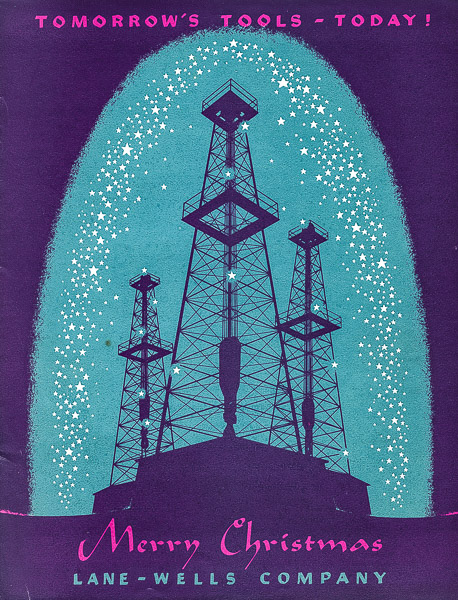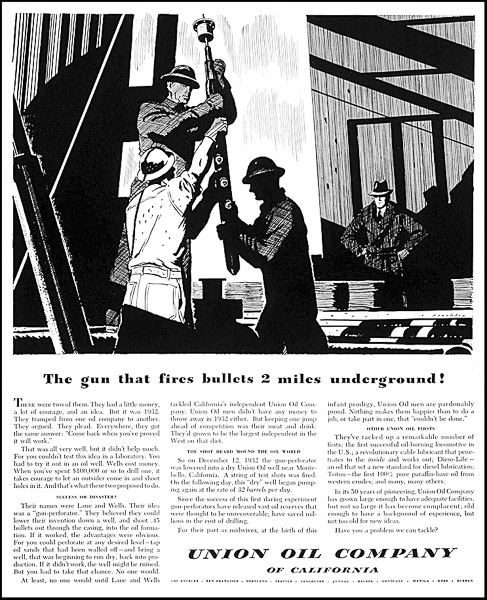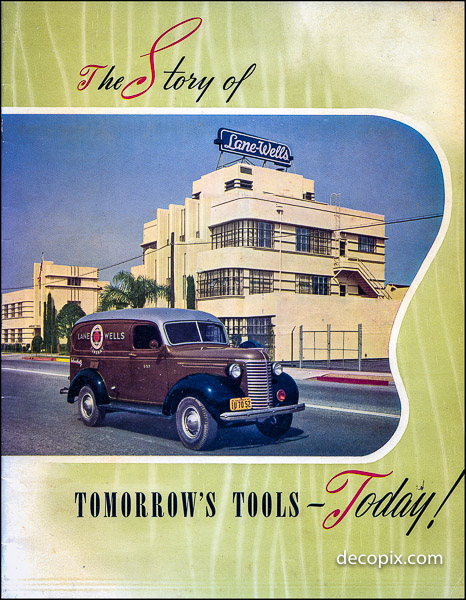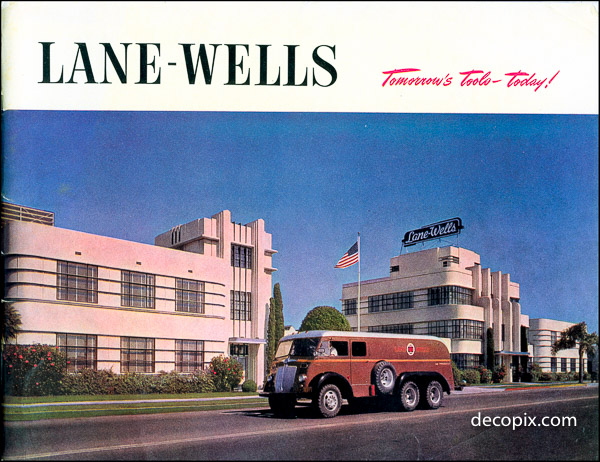
Lane-Wells Company newsletter, December 1939
“The city’s different at night. The airs smells better. Its harder to see that the oil rigs outnumber the palm trees.” –Jack Nicholson as Jake Gittes in The Two Jakes.
In The Two Jakes, the sequel to Chinatown, detective Jake Gittes watches a long California sunset from his streamlined Moderne office. The actual location is the former west coast headquarters of the Lane-Wells Company.
In the movie, there’s an oil rig just outside Jake’s office. This could be an inside joke because there wasn’t any oil drilling on that spot, but Lane-Wells was in the oil business.

Union Oil Company ad explaining the Lane-Wells gun perforator, 1941
In December 1932, Walter T. Wells and Wilfred G. Lane convinced the Union Oil Company to let them test their “gun perforator” on a dry well in Montebello, California. The gun was a device, lowered into the well, that fired .45 calibre bullets laterally into the well housing.
It was dangerous work and carried the possibility of damaging the well. But it worked. The next day, the “dry” well was pumping 32 barrels.
Rejuvenating wells was good business. By 1947, the two-man startup had nearly 100 gun perforating trucks and had completed 92,000 perforating jobs. There were offices in Houston and Oklahoma City plus 40 field branches, but none could compare with company headquarters in Los Angeles.

Lane-Wells brochure, 1947
The work of architect William E. Mayer, Lane-Wells’ west coast headquarters was completed in 1937. Even in a city full of Streamline Moderne buildings, these two were exceptional. In addition to the horizontal banding typical of streamline style, Lane-Wells had vertical bands as well. On the main Administration Building these vertical bands cascade over the top, like a fountain.
Were the vertical bands just a design flourish? Perhaps. Maybe they were meant to create a visual balance with the horizontal bars.
I think the answer is none of the above. I think those vertical bands represent a fountain of oil. This place is an Art Deco temple to the gods of petroleum.
Lane-Wells left the building years ago, ultimately becoming a part of oil giant Baker-Hughes. The L.A. headquarters buildings have had a succession of tenants. The last time I saw the place, it needed some work. With all those windows it must be a challenge to maintain and to keep cool in summer. Hopefully, it will attract someone who can give it the treatment it deserves.

A 1952 view of the Lane-Wells Los Angeles complex. The company built their own streamlined “field unit” trucks. Everything you see here remains, except the truck and the sign.
Hi Randy, Is there any other information you can provide on this building or do you have any suggestions as to where I can find more? Thanks! Ashley
Hi Ashley – I’ve sent this information in a separate email but, as far as I know the only information on the Lane-Wells building is in the Architectural Guide to Los Angeles. Here’s the Amazon link: http://amzn.to/29WegYE
I grew up on the street that ends on this building ☺️ What a landmark
I first noticed this building in the late 1950s when I was a teenager. I remember a small oil rig on the north end of the building. The Art Deco design reminds me of the Whittier High School Auditorium which was built in 1940 in Art Deco/Art Modern style. Whittier had been the home of many suscessful “Oil Men” including R.C. Baker founder of Baker Oil Tools, Johny Riley who founded Fluid Pack Corporation and the Study Company which made carbide welding rod which was used for hard-face welding of drilling tools. Through my father, I met each of these self-made men. In the early 50s one of our local TV stations (probably KTLA channel 5) had a show called “Success Story.” One episode feautured an interview and shop tour with R.C. Baker himself which was very interesting. I remember other episodes but not well.
This story and its photos bring back many happy recollections for me. I financed my education at UC Berkeley by working summers for Lane-Wells, and I recall the experience of working in the oil patch as one of the highlights of my life. I much admired the men I worked with, and I remember even now their names and faces, their capacity for hard work, their good cheer, and their basic authenticity. I have the picture of the Lane-Wells “shooting truck” on my desktop, and I find myself driving again, grinding slowly with my crewmates toward a well site far up on Memory Mountain.
Thanks so much for this. Very interesting!
pls – do you know where we can find detailed technical information /vintage sales & brochures about the tools that Lane Wells run in those days ?
It looks like the Lane-Wells company records are with the University of Southern California. You can try this link:
https://oac.cdlib.org/findaid/ark:/13030/c8th8svw/
I appreciate it the information but I was dying to know where the hell the building was which is not in the article, but thanks.
Hi Bob, I imagine you’ve found it by now, but if not: 5610 S. Soto Street, Huntington Park, Los Angeles.
My father worked for Lane-Wells in Texas, Kansas, and Oklahoma. We moved to various small towns, eventually to Houston where he worked both in the lab and the field traveling nationally and internationally.
Thanks, Judith!
From around 1965 to 1970 we lived in a house at 717 Bedford Drive in Beverly Hills…from when I was 8-13. I found a US passport in the basement belonging to Wilfred G. Lane with an impressive array of visas ranging from Maracaibo, Venezuela to Mexico. I always surmised that the owner had led a life of adventure in the oil business. I presume Mr. Lane and his family lived in the house. When I unpack momentos from LA I’ll scan the passport – the visas alone are works of art – especially the one from Mexico which was a glued-in fold-out multicolored spectacular.
Fascinating, thanks!